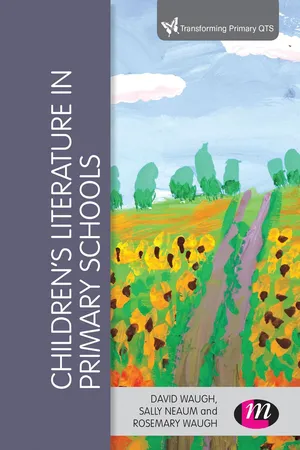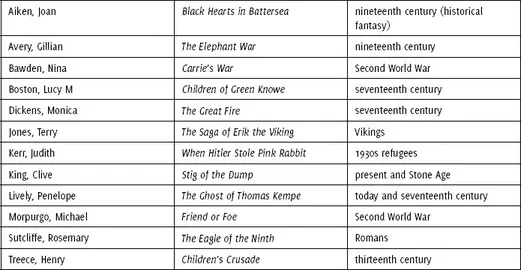
- 256 pages
- English
- ePUB (mobile friendly)
- Available on iOS & Android
Children′s Literature in Primary Schools
About This Book
How can you help children to develop a love of reading and books?Which books are the best ones to use in primary teaching?How do you make the most of children?s literature in teaching across the curriculum? Trainee and experienced primary school teachers need an advanced knowledge of children?s literature. This is your guide to the range of and scope of children?s literature for the primary classroom. Through the exploration of different genres it covers a wide range of literature and helps you to consider what we mean by literature. Case studies that model good practice are included with suggestions for practical activities using literature to enhance teaching across the curriculum. Throughout, book recommendations show how specific texts can be used for teaching in exciting and innovative ways. What?s new to this edition?
- updated in line with the new Primary National Curriculum
- includes new content on supporting children for whom English is an Additional Language
- anextensive list of book recommendationsfor primary teaching
- how to get more out of classic texts
- introduces new texts and new children?s authors
Frequently asked questions
Information
1 Developing a Love of Reading
Learning Outcomes
- how you can make reading an appealing activity;
- why it is important for teachers to be active readers with a wide knowledge of texts;
- strategies for developing children's enthusiasm for and engagement with reading;
- gender issues in reading.
Introduction
Why is it Important to Develop a Love of Reading?
Research Focus
Fiction and Non-Fiction
Fact 1: Fiction is all about a character. Who is your main character? What does he or she look like? Can you describe your character's personality? How did this character get to be this way?Fact 2: Fiction is all about what your character wants. What does your character want more than anything else? Why does your character want it? Some characters want a lot; some want a little. It doesn't really matter as long as what your character wants is extremely important. The more important it is, the more your character will do to get it, and that's what makes the plot so interesting.Fact 3: Fiction is all about how your character gets or does not get what he or she wants. Is your character successful? Or does your character's quest end in failure? Either way, it can still be a great story. The trick is to understand how your character succeeds or fails. What obstacles does your character encounter? What solutions does your character craft to meet the challenges of his or her world?Fact 4: Fiction is all about how your character changes. How does your character change as a result of what happens? What was your character like at the beginning? What is your character like at the end? What has your character learned? What did you learn from reading the story?Fact 5: Fiction is all about a world an author creates. How did the author create the world of the book? What kinds of people, places, things and ideas did the author include? What successes, disasters and conflicts does this world have? What are the good things in this world? What are the bad things? Complete the following sentence: ‘This is a world where …’ Remember: the story is made up, but it is also true to its world.
Activity

Research Focus
Teachers and Reading
… it is questionable whether they know a sufficiently diverse range of writers to enable them to foster reader development and make informed recommendations to emerging readers with different needs and interests. The lack of professional knowledge and assurance with children's literature which this research reveals and the minimal knowledge of global literature indicated has potentially serious consequences for all learners, particularly those from linguistic and cultural minority groups who may well be marginalised unless teachers’ own reading repertoires can be expanded. Furthermore, the infrequent mention of poetry in teachers’ personal reading and their lack of knowledge of poets, as well as the relative absence of women poets and poets from other cultures writing in English, is also a concern, as is the dearth of knowledge of picture book creators, and the almost non-existent mention of picture book writers for older readers.It is debatable therefore whether teachers are familiar with a wide enough range of children's authors in order to plan richly integrated and holistic literacy work. The evidence suggests that if units of work or author studies are undertaken they are likely to be based around the work of writers from the canon, whose writing may already be very well known to children. The wide popularity and teacher reliance on the prolific work of Dahl may...
Table of contents
- Cover
- Half Title
- Title Page
- Copyright Page
- Contents
- The Authors
- Acknowledgements
- Introduction
- 1 Developing a Love of Reading
- 2 Sharing Literature with Children
- 3 Literature Across the Curriculum
- 4 Books for Younger Children
- 5 Picture Books
- 6 Stories and Poems from and about Different Cultures
- 7 Traditional Stories and Fairy Tales
- 8 Fiction which Addresses Issues
- 9 Fantasy and Magic
- 10 Classic Fiction
- 11 Everyday Fiction
- 12 Poetry
- Conclusion
- References
- Appendix 1 Seventy-Five Books
- Appendix 2 Glossary of Terminology for Poetry
- Appendix 3 Model Answers to the Self-Assessment Questions
- References
- Index